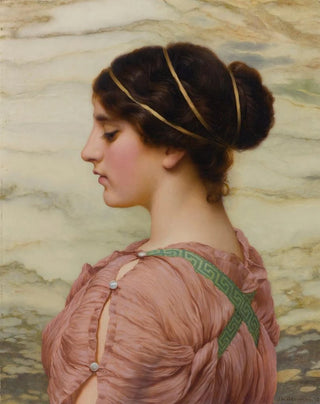Art print | Marcella - John William Godward


View from behind

Frame (optional)
Marcella Art print - John William Godward – Captivating introduction
In the fascinating world of art, some works transcend time and space, captivating souls with their beauty and depth. "Marcella" by John William Godward is one of those creations that invites prolonged contemplation. Created at the end of the 19th century, this piece embodies the very essence of the Pre-Raphaelite movement, blending refined aesthetics with a poignant depiction of femininity. The figure of Marcella, delicately painted, seems to emerge from a dream, enveloped in a halo of light and colors, evoking an atmosphere that is both intimate and universal.
Style and uniqueness of the work
Godward's style is immediately recognizable, characterized by meticulous attention to detail and a palette of vibrant colors. In "Marcella," the harmonious composition and subtle use of shadows and lights create a sense of depth and three-dimensionality. The posture of the figure, both graceful and contemplative, captures a moment of inner reflection, while the drapery of her clothing adds visual dynamism. Every element of the work, from floral ornaments to delicate textures, demonstrates exceptional craftsmanship. Godward manages to fuse classical beauty with modern sensitivity, making his work timeless and always relevant.
The artist and his influence
John William Godward, an emblematic figure of the late 19th century, established himself in the British artistic landscape through his unique approach to painting. Raised in a context where academicism and romanticism prevailed, Godward chose to draw inspiration from old masters while developing his own artistic language. His work is marked by a fascination with feminine beauty, often depicted in mythological or historical contexts. Godward was also influenced by the Pre-Raphaelite movement, whose ideals of returning to nature and seeking pure beauty resonate in his creations. Although his style was criticized for its excessive idealism, he nonetheless left an indelible mark on art, inspiring many contemporary and future artists to explore the delicacy and complexity of the female form.

Matte finish

View from behind

Frame (optional)
Marcella Art print - John William Godward – Captivating introduction
In the fascinating world of art, some works transcend time and space, captivating souls with their beauty and depth. "Marcella" by John William Godward is one of those creations that invites prolonged contemplation. Created at the end of the 19th century, this piece embodies the very essence of the Pre-Raphaelite movement, blending refined aesthetics with a poignant depiction of femininity. The figure of Marcella, delicately painted, seems to emerge from a dream, enveloped in a halo of light and colors, evoking an atmosphere that is both intimate and universal.
Style and uniqueness of the work
Godward's style is immediately recognizable, characterized by meticulous attention to detail and a palette of vibrant colors. In "Marcella," the harmonious composition and subtle use of shadows and lights create a sense of depth and three-dimensionality. The posture of the figure, both graceful and contemplative, captures a moment of inner reflection, while the drapery of her clothing adds visual dynamism. Every element of the work, from floral ornaments to delicate textures, demonstrates exceptional craftsmanship. Godward manages to fuse classical beauty with modern sensitivity, making his work timeless and always relevant.
The artist and his influence
John William Godward, an emblematic figure of the late 19th century, established himself in the British artistic landscape through his unique approach to painting. Raised in a context where academicism and romanticism prevailed, Godward chose to draw inspiration from old masters while developing his own artistic language. His work is marked by a fascination with feminine beauty, often depicted in mythological or historical contexts. Godward was also influenced by the Pre-Raphaelite movement, whose ideals of returning to nature and seeking pure beauty resonate in his creations. Although his style was criticized for its excessive idealism, he nonetheless left an indelible mark on art, inspiring many contemporary and future artists to explore the delicacy and complexity of the female form.






